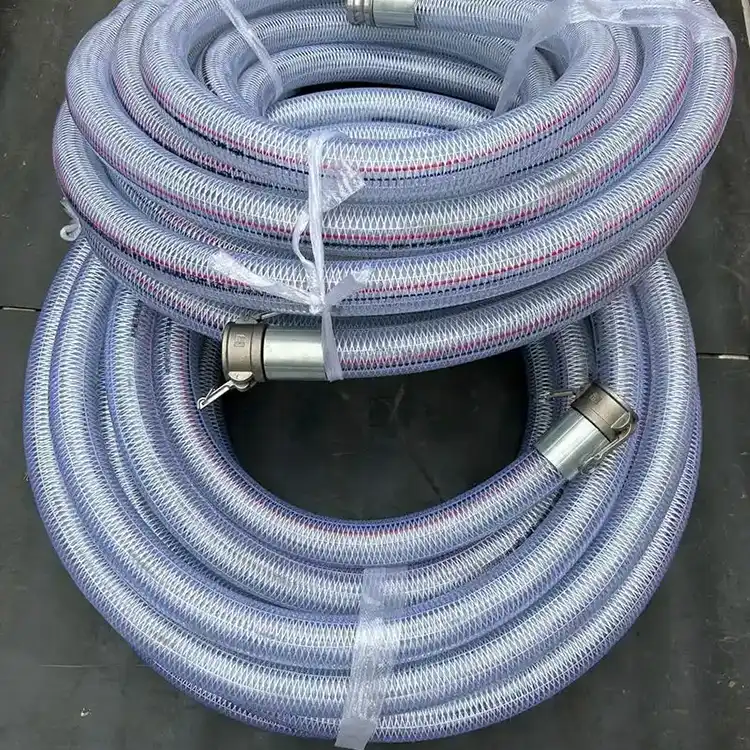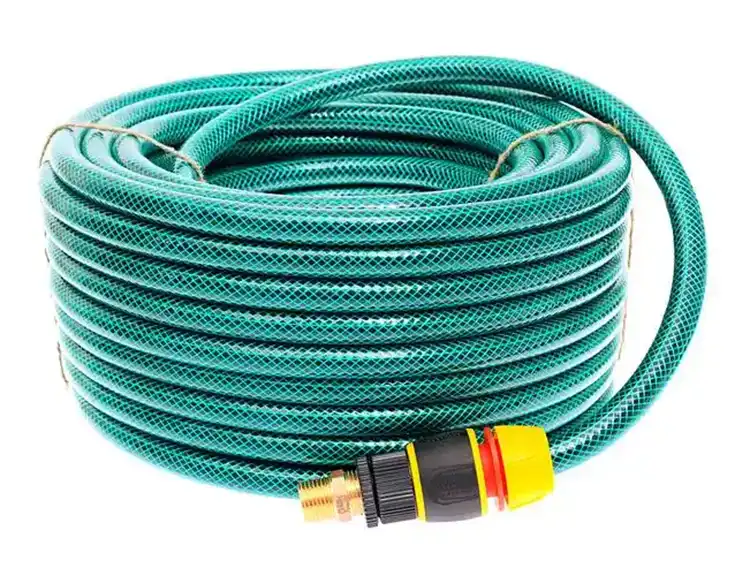1. Introduction: Why Choosing the Right Hose Material Matters
Not all hoses are created equal—choosing the wrong material could lead to leaks, early wear, or even system failure. Imagine a chemical plant forced to halt production due to hose corrosion, or a homeowner frustrated by a garden hose cracking in the winter. These are not rare scenarios—they happen every day because of a simple oversight: the wrong hose material.
Hoses are everywhere. From transferring aggressive chemicals in industrial plants to watering flowers in your backyard, they are vital connectors between systems and end-use applications. But the demands in each situation are dramatically different, and selecting the right material could be the difference between a long-lasting solution and constant replacements.
This comprehensive guide is designed for industrial buyers, product designers, R&D teams, and even homeowners. I’ll compare composite, rubber, PVC, polyurethane (PU), and silicone hoses across performance factors, real-world use cases, and maintenance considerations. Whether you’re specifying hoses for a high-pressure chemical system or choosing one for your garden, this article will give you the clarity you need.
Here are proven insights that will help you make an informed decision and avoid costly mistakes.
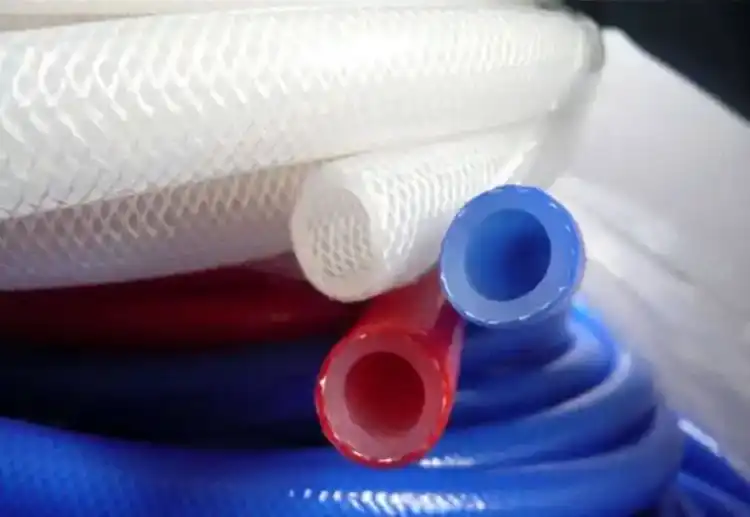
2. Overview of Common Hose Materials
2.1 Composite Hose
Composite hoses are engineered with multiple layers of thermoplastic films and fabric reinforcements, all wrapped around a metal inner helix and an outer wire for strength. This unique construction gives them excellent chemical resistance and flexibility while keeping the weight relatively low.
Key Features:
- Exceptional resistance to a wide range of aggressive chemicals and hydrocarbons.
- Lightweight design for easier handling and installation.
- Flexibility allows them to adapt to complex routing in tight spaces.
Typical Applications:
Composite hoses are the go-to choice in industries such as chemical processing, petroleum handling, and oil & gas transfer. Their ability to safely handle hazardous materials makes them indispensable in applications requiring high safety and reliability standards.
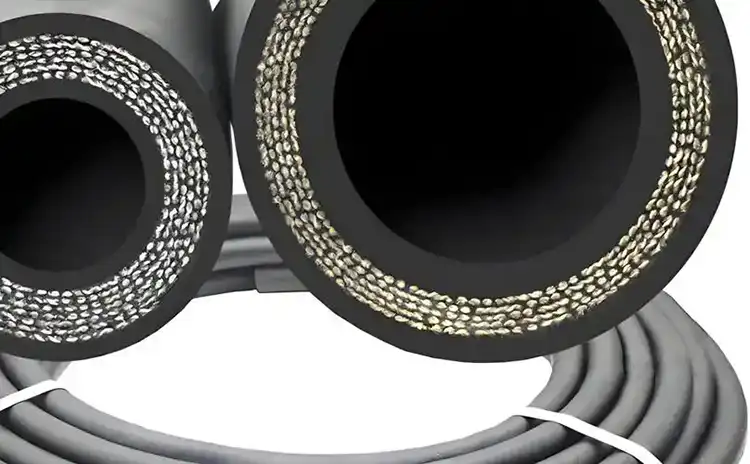
2.2 Rubber Hose
Rubber hoses are some of the most versatile options, available in natural rubber or synthetic variants like EPDM (ethylene propylene diene monomer) and NBR (nitrile butadiene rubber). These materials are known for their resilience and adaptability.
Key Features:
- High flexibility and durability.
- Excellent abrasion and wear resistance.
- Capable of withstanding a wide range of temperatures.
Typical Applications:
Rubber hoses are commonly used for air and water delivery, food-grade applications (when made from FDA-compliant materials), automotive systems, and heavy-duty industrial use where ruggedness is essential.
2.3 PVC Hose
Polyvinyl chloride (PVC) hoses are cost-effective and widely used for light-duty tasks. Their lightweight nature makes them popular for everyday applications, but they come with limitations.
Key Features:
- Economical and lightweight.
- Resistant to many mild chemicals and water-based fluids.
- Easy to handle for non-demanding applications.
Limitations:
PVC hoses have poor performance under high temperatures or prolonged UV exposure, making them less durable in outdoor or high-heat environments.
Typical Applications:
Ideal for low-pressure water delivery, temporary setups, and occasional garden use.
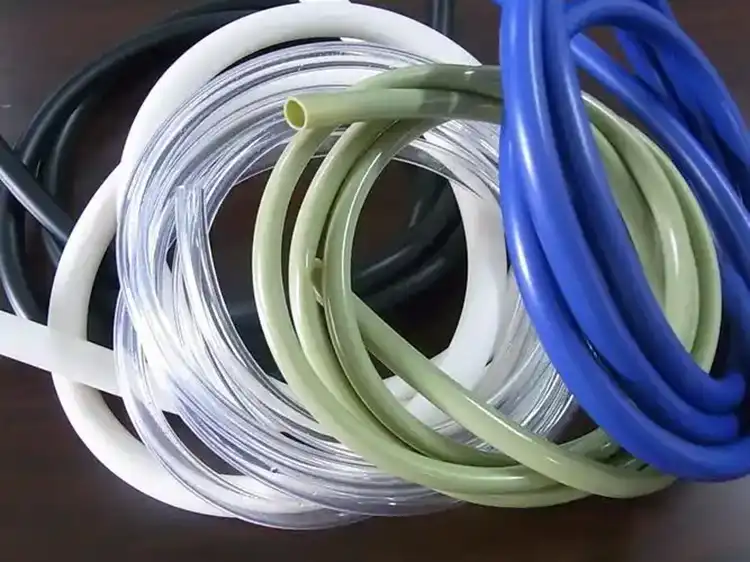
2.4 Polyurethane (PU) Hose
Polyurethane hoses strike a balance between flexibility and toughness, making them popular in dynamic applications.
Key Features:
- Superior abrasion resistance compared to PVC and rubber.
- Good flexibility and lightweight design.
- Maintains performance even in cold environments.
Typical Applications:
Widely used in pneumatic tools, granular material handling, and environments where hoses are subject to constant movement or abrasion.
2.5 Silicone Hose
Silicone hoses excel in extreme environments due to their remarkable temperature tolerance and inert properties.
Key Features:
- Withstands temperatures from -60°C to +200°C (and even higher for specialized grades).
- FDA and NSF-approved options for food, beverage, and medical use.
- Excellent flexibility and non-reactive to most chemicals.
Typical Applications:
Preferred in medical devices, food and beverage processing, and industrial systems where cleanliness and heat resistance are critical.
3. Composite Hose vs Rubber Hose: Detailed Comparison
3.1 Performance Factors
When choosing between composite and rubber hoses, understanding their performance differences is critical. Below is a side-by-side comparison of key attributes:
| Feature | Composite Hose | Rubber Hose |
|---|---|---|
| Temperature Range | -30°C to +150°C | -40°C to +120°C |
| Chemical Resistance | Excellent (broad range) | Good (limited by rubber type) |
| Weight | Lightweight | Heavier |
| Flexibility | Moderate (stiff under low temp) | Excellent, especially EPDM |
| Abrasion Resistance | Moderate | Excellent (ideal for rough use) |
| Cost | Higher upfront | Moderate |
Key Takeaway:
Composite hoses outperform in chemical resistance and weight-sensitive applications, while rubber hoses excel in flexibility and abrasion resistance for rugged environments.
3.2 Installation & Maintenance
Composite Hose:
- Easier to install due to lighter weight.
- Requires careful handling to avoid kinks or crushing of the layered structure.
- Periodic inspection is crucial because damage to the outer layer can expose inner linings.
Rubber Hose:
- Heavier, which can be a challenge during installation in large systems.
- More forgiving of rough handling and suitable for environments with high physical stress.
- Simple maintenance—visual inspections and occasional pressure testing.
3.3 Best Use Cases
- Composite Hose: Ideal for transferring aggressive chemicals, fuel oils, and in long-distance or overhead applications where weight matters.
- Rubber Hose: Best suited for general-purpose industrial use, high-abrasion zones, and situations requiring frequent flexing and movement.
4. Garden Hose Materials: Which One Fits Your Needs?
Choosing the right garden hose isn’t just about price—it’s about durability, ease of use, and suitability for your environment. Let’s break down the most common materials and their pros and cons.
4.1 Rubber Garden Hose
Pros:
- Highly durable and resistant to abrasion.
- Kink-resistant and retains flexibility even in cold weather.
- Handles higher water pressures without bursting.
Cons:
- Heavier than other hose types, making it harder to drag across large areas.
- More expensive upfront compared to PVC hoses.
Best For:
Long-term use in professional landscaping, commercial settings, or for homeowners who need a hose that can withstand frequent heavy use.
4.2 PVC Garden Hose
Pros:
- Lightweight and easy to handle.
- Very affordable—ideal for budget-conscious buyers.
Cons:
- Prone to kinking and becoming stiff in cold weather.
- Lower durability; may crack or degrade under UV exposure over time.
Best For:
Light-duty, occasional watering or small gardens where the hose isn’t in constant use.
4.3 Polyurethane (PU) Garden Hose
Pros:
- Excellent flexibility with lightweight design.
- Highly abrasion-resistant and safe for potable water (lead-free and BPA-free).
- Remains flexible in extreme cold.
Best For:
Frequent use in residential settings, RV owners, or potable water applications.
4.4 Silicone Garden Hose
Pros:
- Extreme temperature resistance makes it usable in hot and cold climates.
- Inert and safe for drinking water (FDA-grade options available).
Cons:
- Significantly more expensive than other materials.
- Niche application due to high cost and specialized properties.
Best For:
Applications requiring food-grade safety, medical settings, or environments with wide temperature fluctuations.
5. How to Choose the Best Hose for Your Application
5.1 Factors to Consider
Selecting the right hose isn’t just about knowing the materials—it requires evaluating your specific application demands. Here’s what I recommend checking before you buy:
- Fluid Type:
Ensure the hose material is chemically compatible with the fluid being transferred. For aggressive solvents, composite or silicone may be necessary. - Pressure Rating:
Check both the working pressure and burst pressure. Industrial systems often demand reinforced hoses to handle surges. - Temperature Range:
Consider the operating environment. Rubber works well in cold climates, while silicone and composite hoses handle extreme temperatures. - Flexibility & Weight:
If the hose needs frequent repositioning, prioritize flexibility and lightweight options like polyurethane or composite. - Cost vs Lifespan:
Don’t just look at the upfront price. A more durable hose may save costs over time by reducing replacements and downtime.
5.2 Industrial Buyers Checklist
- Verify standards compliance (EN ISO 1402, ASTM D380, FDA for food-grade).
- Consider reinforcement options (textile braid, steel wire helix).
- Evaluate customization needs: liners, fittings, anti-static layers.
- Assess the total cost of ownership (TCO), not just purchase price.
5.3 Home Users Checklist
- Ensure drinking water safety certifications (NSF, FDA) for potable applications.
- Check UV and kink resistance for outdoor use.
- Think about storage—some materials like PVC can degrade faster if left exposed to sunlight.
- Match hose length and diameter to your water pressure to avoid flow issues.
6. Real-World Case Studies: Industrial & Home Use
Case Study 1: Chemical Plant Switching from Rubber to Composite Hose
Problem:
A chemical manufacturing plant in Southeast Asia experienced frequent rubber hose failures when transferring aggressive solvents like acetone and methanol. The hoses degraded within months, leading to costly downtime and hazardous leaks.
Solution:
The plant upgraded to composite hoses with multilayer thermoplastic linings designed for chemical resistance. These hoses handled the aggressive fluids with no signs of deterioration even after 18 months of continuous use.
Result:
Hose replacement frequency dropped by 60%, and maintenance costs were cut in half. The lighter composite hoses also reduced worker fatigue during installations.
Case Study 2: Commercial Landscaping Contractor
Problem:
A landscaping contractor serving large urban parks relied on PVC hoses due to their low cost. However, in winter, the hoses became stiff and cracked, resulting in frequent replacements and interruptions to scheduled work.
Solution:
The contractor switched to heavy-duty rubber garden hoses, which stayed flexible even in sub-zero temperatures and resisted kinking.
Result:
Downtime caused by hose failures was eliminated, and despite the higher initial investment, the contractor saved money over two years due to reduced replacement needs.
7. FAQs
Which hose material lasts the longest?
Rubber and composite hoses typically offer the longest service life in industrial settings due to their durability and resistance to wear. For home use, polyurethane hoses are an excellent long-term option because they combine flexibility with abrasion resistance.
Are composite hoses safe for food-grade applications?
Generally, no. Composite hoses are designed for industrial chemicals and fuels. For food-grade applications, silicone or FDA-approved rubber hoses are the preferred choices because of their inert properties and compliance with sanitary standards.
What’s the best garden hose for cold climates?
Rubber garden hoses outperform others in cold weather, maintaining flexibility and resisting cracking. Polyurethane hoses are also a solid choice for regions with freezing temperatures.
Can I use a rubber hose for chemical transfer?
It depends on the chemical. Rubber hoses are suitable for many mild chemicals, but aggressive solvents and hydrocarbons may degrade them quickly. For such applications, composite hoses with specialized liners or fluoropolymer-lined hoses are recommended.

8. Conclusion: Make the Right Choice for Long-Term Reliability
Choosing the right hose material is not just about specifications—it’s about ensuring safety, efficiency, and longevity in your application. From industrial chemical transfers to watering a home garden, each scenario demands careful material selection.
Here’s the recap:
- Composite hoses are ideal for aggressive chemicals and long-distance transfers where weight and chemical resistance matter most.
- Rubber hoses excel in rugged environments and cold climates, providing flexibility and durability.
- PVC hoses are budget-friendly for light-duty, occasional use.
- Polyurethane hoses offer excellent abrasion resistance for frequent handling.
- Silicone hoses shine in high-temperature and sanitary applications.
Need help selecting the perfect hose for your application? Contact our experts at KINSOE for tailored recommendations and premium hose solutions.

